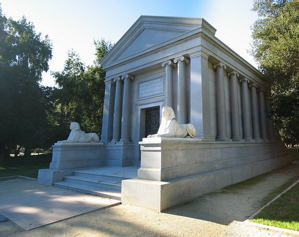By Carl Johnson
The University at Albany surely has its fine points, but even its greatest advocates would agree, it's no Stanford.
But it could have been Stanford.
Literally.
Leland Stanford was born in Watervliet in 1824 (the area that is now part of Colonie). His father was a tavern keeper on the Schenectady road, who later ran the Elm Grove Hotel in Roessleville. Leland left home at 17 to study in Clinton and Cazenovia. He apprenticed in law in Albany, was admitted to the bar in 1848 and eventually married Jane Lathrop, the daughter of a prominent local family.
He briefly practiced law and politics in Wisconsin. But his brothers had followed the gold rush to California, and Leland soon joined them. He established a retail store in Sacramento, but stayed active in politics and was elected governor of California in 1861. That same year, he and some other Sacramento businessmen founded the Central Pacific Railroad Company, which proved to be of much greater interest. He served only one term as governor, but remained president of the Central Pacific for many years, becoming one of the richest men in the United States.
The Stanfords had only one child, Leland Junior, and they were grief-stricken when he died suddenly of typhoid at the age of 16 during a family vacation in Europe in 1884. Despite their huge success and influence in California, they wanted their son buried where their families were from. The Troy Press wrote in 1891 that, "at the same time he had in mind a disposition of his millions that should forever celebrate the name of his son and that should be useful to the public."
A university, for instance. The Press reported that Stanford began negotiations with the Albany Rural Cemetery Association to purchase a site for a mausoleum, and at the same time looked to buy 350 acres of land, including his birthplace, just west of Albany in order to build Leland Stanford, Jr. University.
So how did Stanford University end up in Palo Alto instead of Albany?
If the Troy Press is to be believed, it may have been the greed of the cemetery association, whose officers "it is said, knowing Mr. Stanford's great wealth and his greater grief, seemed to be of the opinion that they could get from him a little more for the mausoleum site than a person of ordinary means would be asked. The sum which it is said they endeavored to extort was $75. . . ." [about $1,700 in today's money].
Stanford may have been fabulously well-to-do, but apparently he didn't like being taken advantage of. The Press says that on discovery of this fact, "He shook the dust of Albany from his feet and went back to California, where he immediately entered upon the development of his university project." He endowed the new university with $20 million. And he put his son's mausoleum on his own unfinished new estate, which became the home of Stanford University. After Leland died in 1893, Jane led the development of the university.

The family did not entirely break their ties with Albany, however. In 1886, before the university's cornerstone had been laid, Mrs. Stanford established a building on the site of the old Lathrop mansion in Albany, near the Fort Orange Club, as the Lathrop Memorial Home for Children, intended as part day care ("for children of working mothers"), part orphanage. The building stood until 1933.
Albany would have to wait until 1962 before it finally had a university.
Comments (0)
You don't have permission to comment on this page.